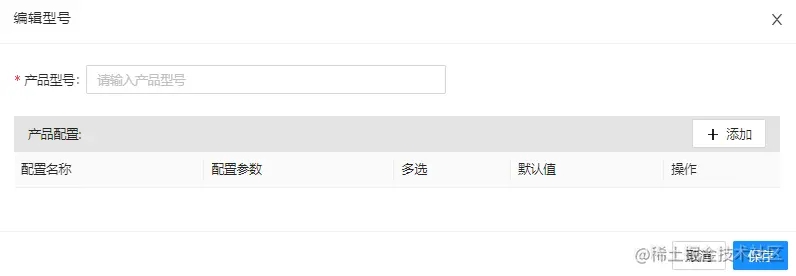业务场景
使用formarray制作动态表单。每创建一个表单,页面就新增一个input显示表单填写的标题,点击编辑再跳转到点击表单的填写内容。
// 封装获取modellist
get modellist() {
return this.formgroup.get('modellist') as formarray
}
constructor(private fb: formbuilder) {}
ngoninit() {
// 一开始初始化arr为空数组
this.formgroup = this.fb.group({
// 内部嵌套formcontrol、formarray、formgroup
modellist: this.fb.array([])
})
}
// 模态框构造内部的表单
function newmodel() {
return this.fb.group({
modelname: [''],
// 可以继续嵌套下去,根据业务需求
})
}
// 省略模态框部分代码
// 传递到模态框的formarray
selectedtype: formarray
表单列表

表单详情【模态框】

<form [formgroup]="formgroup">
<div formarrayname="modellist">
<ng-container *nffor="let item of modellist.controls;let i = index" [formgroupname]="i">
<nz-input-group
[nzsuffix]="suffixiconsearch"
>
<input type="text" nz-input formcontrolname="modelname"/>
</nz-input-group>
<ng-template #suffixiconsearch>
<span
nz-icon
nztype="edit"
class="hover"
(click)="showmodal(i)"
></span>
</ng-template>
</ng-container>
</div>
</form>
<nz-modal
[(nzvisible)]="isvisible"
nztitle="model"
[nzfooter]="modalfooter"
(nzoncancel)="handlecancel()"
(nzonok)="handleok()"
>
<ng-container *nzmodalcontent>
<form nz-form [formgroup]="selectedtype">
<nz-form-item>
<nz-form-label nzrequired>model test</nz-form-label>
<nz-form-control>
<input
type="text"
nz-input
placeholder="请输入modelname"
formcontrolname="modelname"
/>
</nz-form-control>
</nz-form-item>
<nz-form-item>
<nz-form-control>
<product-config></product-config>
</nz-form-control>
</nz-form-item>
</form>
</ng-container>
<ng-template #modalfooter>
<button *ngif="!isnewmodel" nzdanger nz-button nztype="default" (click)="handledelete()">删除</button>
<button *ngif="isnewmodel" nz-button nztype="default" (click)="handlecancel()">取消</button>
<button nz-button nztype="primary" (click)="handleok()">保存</button>
</ng-template>
</nz-modal>
由于这种模态框比较特殊,割裂了表单的formgroup之间的关系,在点击的时候需要传递参数到模态框显示部分值,如果单纯传递参数使用this.modellist.at(index)获取实体到模态框上进行赋值修改,在模态框点击保存后会发现修改的值没有在表单更新,而表单上对input值修改发现可以影响到模态框的内容。
但是模态框新增的表单却可以响应到页面中去。
原错误代码思路
- 点击编辑后,将点击的formarray的元素传递给一个临时变量
this.selectedtype = <formgroup>this.modellist.at(index);,并且对模态框表单传值。 - 模态框点击保存再将原formarray的值重新替换
this.modellist.removeat(this.modelindex) this.modellist.insert(this.modelindex, this.selectedtype)
- 点击新增,创建一个新的formgroup对象
- 保存添加push到原页面的formarray中
newmodeltype(): formgroup {
return this.fb.group({
modelname: ['', validators.required],
configlist: this.fb.array([]),
});
}
// ...省略
// 模态框显示
show() {
this.isvisible = true
this.selectedtype = this.newmodeltype();
}
// 保存
save() {
this.isvisible = false
// 原页面formarray
this.modellist.push(this.selectedtype);
}
最后发现这种写法只能够单向改变,页面外input修改值会影响到模态框,但是模态框的值改变保存却让外部没有更新。通过console方式查看页面的formarray内部参数发现其实是有改变的,只是angular没有检测到。这个时候判断没有发生响应的原因一般是没有触发angular检测机制,仔细查看文档发现有一行很重要 angular文档 在最下面写着

原本第一次阅读的时候,觉得我遵守了这种原则,因为在编辑的时候,我选择了操控原formarray进行元素删除和插入,是遵循了这种规则,但是实际上在模态框赋值就已经违反了这种原则,我在赋值的时候拿了formarray的元素实例赋值给模态框的临时变量,然后更改实例的值,又重新删除插入,本质上操作的是同一个实例,所以angular没有检测到发生变化【虽然值发生改变】
this . mode llist. removeat ( this . mode lindex ) this . modell ist. insert(this . modelindex, this . se lectedtype)
所以正确的做法是啥??
在赋值的地方不能偷懒,仍然要重新创建新对象,再拿原对象的赋值。【相当于深拷贝】
this.selectedtype = this.newmodeltype();
const old = this.modellist.at(index);
this.selectedtype.setvalue({
'modelname': old.get('modelname').value
})
这时候就可以正常更新了。
总结
其实查到最后本质上还是回归文档。在排查错误也走了很多坑,而且国内基本没什么angular的文章,还得靠外网论坛去找问题。
以上就是angular的formarray和模态框结合使用实例详解的详细内容,更多关于angular formarray模态框的资料请关注代码网其它相关文章!







发表评论